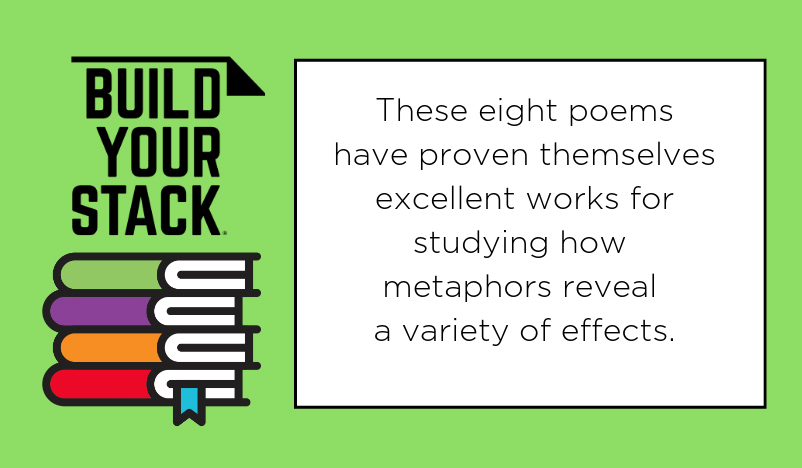This blog post is part of Build Your Stack,® a new initiative focused exclusively on helping teachers build their book knowledge and their classroom libraries. It was written by NCTE member Wesley Matlock.
To rework an old adage: the divine is in the details. And poetry is the best medium for parsing details for greater reward.
In a previous #BuildYourStack post, I shared four public-domain poems to draw students into diction-level detail to promote discussion of thematic content. This time, I’m sharing eight public-domain poems that are perfect for teaching how to explore the power of metaphors.
Since metaphors express images, emotions, actions, experiences, and nuances through direct and indirect comparisons, attentive readers can grasp deeper levels of meaning in the text with careful analysis. However, in practicing this level of analysis, finding ideal poems can be difficult. In selecting a good poem for practicing analyzing and explaining metaphors, I look for the following:
- A poem that employs figurative language
- A poem that is accessible at different skill levels
- A poem that rewards readers with further study
To that end, I’ve been working with eight poems that have proven themselves excellent works for studying how metaphors reveal a variety of effects:
“A Little Bird I Am” by Louisa May Alcott
“Impressions” by Alice Dunbar-Nelson
“Spring-Watching Pavillion” by Ho Xuan Huong
“Spring” by Edna St. Vincent Millay
“Humayun to Zobeida” by Sarojini Naidu
“Goblin Market” by Christina Rossetti
The poems by Alcott and Lowell are ideal introductions to poems with a conceit, an elaborate or extended metaphor, and explore how additional metaphors enhance the poem’s premise.
- At first glance, “A Little Bird I Am” appears traditional, employing a light-hearted, rhyming structure. Yet since Alcott constructs the speaker’s entire situation as that of a bird within a cage, a satirical edge sharpens the extended metaphor, illustrating her wit and condemnation of oppression.
- In “Patterns,” Lowell introduces what seems like a celebration of spring. However, once the speaker claims that she is “a rare Pattern,” Lowell establishes the poem’s conceit. Readers are brought into a world of patterns in which the speaker, her dress, her garden, and her life conform to tradition, confining her to a particular way of being. Poignant metaphors around her dress, garden, and relationship to her lover emphasize her plight, building on the poem’s extended metaphor.
The poem by Alice Dunbar-Nelson also deals with extended metaphors and is an excellent example of how metaphors can provide more depth to abstract concepts. Consider encouraging your students to use metaphors to explain what such concepts mean to them.
- In “Impressions,” Dunbar-Nelson explores five concepts—Thought, Hope, Love, Death, and Faith—in five stanzas. Each concept is the title of a stanza, and the content of each stanza serves as an extended metaphor meant to illuminate the concept through the comparison. For instance, while “Hope” is presented as a sudden flash of light from the shore amidst the “wild seas of tossing, writhing waves,” “Love” is “a bed of roses” that are pleasing but also have “cruel thorns [that] piece soul and heart.”
The poems by Ho and Millay are prime candidates for seeing how metaphors can reveal themes, with each offering a subversive take on our traditional spring associations of hope and renewal.
- In “Spring-Watching Pavilion” (translated by John Balaban), Ho crafts a speaker whose desire for peace is at tension with the civilized world. Through vivid metaphors, she conveys the ubiquity and futility of organized religion, all while suggesting that “Nirvana is here, nine times out of ten.”
- In “Spring,” Millay upends the traditional springtime associations through a darkly comedic interrogation of the season, portraying April as “an idiot, babbling and strewing flowers.” Millay conveys the poem’s humorous tone and enhances the impact of her speaker’s conclusions through several cutting metaphors.
The poem by Sarojini Naidu serves as an exemplar of how close reading of metaphors can uncover the layered meanings within a text.
- In “Humayan to Zobeida,” Naidu depicts an encounter between the speaker (presumably a man) and his beloved (presumably a woman). He speaks to her initially through abstract metaphors that, upon close investigation, reveal that his compliments have a sting of accusation. In the second stanza, the speaker employs similes to show how her actions affect him. When readers finally experience words from the woman, “I sit behind the veil, I cannot show my face,” and hear the speaker’s retort, the poem takes a turn. Though the man returns to constructing his professed love through metaphor, readers now question the purity of his motivations.
Finally, the poems by Moore and Rossetti are excellent examples of how a poet can use metaphor to enhance imagery.
- I mentioned “The Fish” by Marianne Moore in my previous post, and it, like so many of her other poems (“Poetry” and “To a Steam Roller” come to mind), employs evocative images and incisive metaphors. Moore offers a melancholic, imaginative, and captivating exploration of marine life that is revealed through her use of carefully constructed metaphors.
- Rossetti’s “Goblin Market” has often been approached through the lens of a moral story, as a cautionary tale for children. However, a closer look at Rossetti’s use of metaphor enriches the evocative imagery within this fairy-tale parable, allowing your students opportunities to explore deeper meanings within the poem.
Many exercises around analyzing and explaining metaphors can be repetitive and stilted. That’s why I’m glad to have these poems in my “stack” of works for teaching middle and high schoolers how to comprehend and appreciate the impact of well-crafted metaphors.
 Wesley Matlock is Project Manager at eNotes.com and an avid reader of whatever he can get his hands on. Before life in editing and publishing, he spent many years teaching English Language Arts from Moscow, Russia, to Seattle, Washington. He has presented at EFL conferences in Moscow, Prague, and Rome, all in service to advocating for student-centered learning experiences. He now works with a great team of literature enthusiasts who seek to make reading and teaching literature as enjoyable and rewarding as possible.
Wesley Matlock is Project Manager at eNotes.com and an avid reader of whatever he can get his hands on. Before life in editing and publishing, he spent many years teaching English Language Arts from Moscow, Russia, to Seattle, Washington. He has presented at EFL conferences in Moscow, Prague, and Rome, all in service to advocating for student-centered learning experiences. He now works with a great team of literature enthusiasts who seek to make reading and teaching literature as enjoyable and rewarding as possible.

